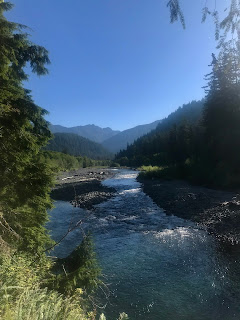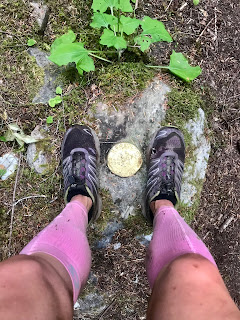The day was cool to begin with but warmed up very rapidly and became sticky and muggy. The trail was delightfully clear and the sunlight was amazing filtering through the old growth cedar trees. The trail on this side of the mountain is rocky and you start climbing up to the Low Divide almost immediately, though lots of this section is very runnable.
I switched up my hydration method this year because I knew there was a lot of water on the trail. I still carried a bit over a liter of water at a time but I used a Katadin BeFree filter my boyfriend gave me, which cut down on filtration time A LOT. There was a lot of trail work being done on the Quinault side and I was really happy to run into a couple of student crews; they were friendly and chatty and cheered me on as I trotted by. Thank you SO much for the hard work, the trail is looking SO AWESOME!
The Quinault River crossing (and all the creek crossings) are very manageable right now-- the river is only about knee high and was refreshingly cool. I started running into blowdowns around mile 12, though none were really terrible until the old slide at 13.25. I remembered it from last year and didn't give myself much time to remember how disconcerting it was to scramble across it. It is totally passable, though it would be tough with a backpack, I just don't particularly like creeping across slide plugs like that. There was a survey marker I don't remember running into when I was just about to the final climb up to the Low Divide and you can see that the trail was a little bit boggy in places from the condition of my shoes. Careful if you try to step around the boggy parts, there's a lot of Devil's Club growing along the edges.
There's no way else to describe the Divide than GORGEOUS! Last year I spent so much time exclaiming over the views and the colors and the waterfalls cutting down the sides of the mountains and I could have easily done the same this year but kept myself moving after a few snapshots. The little streams that form the headwaters of the river are perfect for soaking your feet or just refilling your water pack but you should expect to get your feet wet.
I felt like I was on track for a pretty quick descent through the Elwha River Valley but the trail was quite different from last year. The salmonberry and thimble berry bushes are pretty overgrown right now and hid lots of hazards like rocks, tripwire branches, and lots of step-downs so I highly suggest you descend carefully. I took a couple of headlong falls and got pretty banged up through this section and the full-body experience continued for quite a while with lots of blow-downs from this previous winter. Some were really passable and easy to step over and others were rats nests of several trees piled up and blocking big parts of the trail. If you're ever in doubt of where the trail continues, look for the pink and yellow flagging tape that shows you where the trail continues. Don't get too distracted though, the old growth trees are stunning!
I regret not marking the mileage where I encountered one particular fall but it's along the easy rolling section after you cross the Elwha River (perfect place for a dip!). An old deadfall landed along the trail and broke in half, making a little gate you can pass through. It looked easy enough, just run alongside the old log until you get to the break but BE CAREFUL because there are several jagged broken branches along its length and I ran right into one, gouging my right shin and helping me get pretty creative with my language. The only other section I found a little sticky was the second Elwha crossing-- a footlog crossing that has been a little crunched by blowdowns. You can cross the river on foot if you need to at this point but the log itself is still intact, you just have to scramble a little to get on the log. The trail gets really gorgeous at this point and a little bit softer on the feet, which is nice after the rocky trail up and down the Low Divide.
This might be my favorite section of the trail, everything is fuzzy and green. The blowdown section slowed me down quite a bit so I pushed the pace as much as I felt was safe in order to finish well before dark. You'll exit the mossy section after a few miles and need to watch out for nettles and roses growing really thickly into the trail. Splash straight through the muddy sections because stepping to the side pretty much guarantees you'll get hit by one or the other. Once you're in the last 10 miles you'll start to see evidence of trail work.
I was having trouble smiling for the last few pictures because my legs were scratched and stinging and I was still grumpy from tumbling down the Low Divide but pushed myself up the last three inclines; I was looking forward to seeing my boyfriend and just... not running for a bit.
I had landed on my quad during one fall and that made the inclines really challenging but the trail is also beautifully clear and totally runnable. The end of the trail comes very shortly after the third incline and is downhill all the way out. I snapped a picture next to the trailhead signage and took a seat on the picnic table nearby for a little bit before tackling the 6.5 miles from trailhead to parking area below the washout. Be careful if you're doing this in the dark, which we did since I finished around 9pm, because there are lots of critters out there. We saw a few deer but also two cougars within 50 feet of us.
My totals:
Garmin Forerunner: 45.2miles, 12:29:22 total elapsed time, 7,430 feet of gain, 6,782 loss
Strava: 44.73 miles, same elapsed time, 8,565 feet of gain, no reported loss
Thanks to my boyfriend for the cheerful sendoff at the beginning and welcome at the end, for stumbling around with me in the dark at the end, and hugging me so much even though I smelled like a bog monster! Thanks also to my dear friend Jessica for loaning me her InReach and keeping tabs on me while I ran.









































